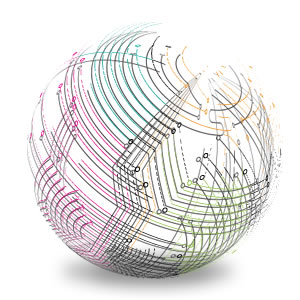Science & Technology
Powerful 'Gene Drive' Can Quickly Change An Entire Species

Biologist Ethan Bier runs a laboratory at the University of California, San Diego where fruit flies are used to help unravel the processes that lead to some human diseases. One day recently, a graduate student in the lab called him over to take a look at the results of the latest experiment.
Bier was stunned by what he saw. "It was one of the most astounding days in my personal scientific career," Bier says. "When he first showed me, I could not believe it." His student, Valentino Gantz, had found a way to get brown fruit flies to produce blond-looking offspring most of the time.
"When the next generation came out and almost all the kids were blond," Bier says, everyone in the lab was "jumping up and down." Turning fruit flies from brown to yellow might not sound like a major achievement. But it was. It showed that scientists had a very fast and easy way to permanently change an entire species ...Read more
How Sound Shaped The Evolution Of Your Brain
Acoustic biologists who have learned to tune their ears to the sounds of life know there's a lot more to animal communication than just, "Hey, here I am!" or "I need a mate."
From insects to elephants to people, we animals all use sound to function and converse in social groups — especially when the environment is dark, or underwater or heavily forested.

"We think that we really know what's going on out there," says Dartmouth College biologist Laurel Symes, who studies crickets. But there's a cacophony all around us, she says, that's full of information still to be deciphered. "We're getting this tiny slice of all of the sound in the world."
Recently scientists have pushed the field of bioacoustics even further, to record whole environments, not just the animals that live there. Some call this "acoustic ecology" — listening to the rain, streams, wind through the trees. A deciduous forest sounds different from a pine forest, for example, and that soundscape changes seasonally ...Read more »
Scientists are trying to figure out the best way to spend money on science
A provocative new study by two biologists appears at first glance to highlight a worrisome paradox: As the nation's investment in the science that underlies new therapies has increased over the past half century, the output that we actually care about most -- advances in health -- appears to be slipping.
 If the federal investment in biomedical research is really getting less efficient over time by yielding fewer new drugs and additional years of life, that would be a clear call to reexamine policy. After all, the goal of the roughly $30 billion spent by the National Institutes of Health each year isn't merely to provide jobs for scientists and create reams of erudite scientific papers, but to help people live longer and better. But the analysis, published Monday in the Proceedings of the National Academy of Sciences, raises far more questions than it answers and may in fact reveal how little we know about how to measure the bang for our buck when it comes to funding the insights and innovations that improve health ...Read more »
If the federal investment in biomedical research is really getting less efficient over time by yielding fewer new drugs and additional years of life, that would be a clear call to reexamine policy. After all, the goal of the roughly $30 billion spent by the National Institutes of Health each year isn't merely to provide jobs for scientists and create reams of erudite scientific papers, but to help people live longer and better. But the analysis, published Monday in the Proceedings of the National Academy of Sciences, raises far more questions than it answers and may in fact reveal how little we know about how to measure the bang for our buck when it comes to funding the insights and innovations that improve health ...Read more »
With Discovery, 3 Scientists Chip Away At An Unsolvable Math Problem

Jennifer McLoud-Mann had almost come to believe that her last two years of work had been for naught.
"It had gotten to the point, where we hadn't found anything," she said. "And I was starting to believe I just don't know if we're going to find anything."
Armed with an algorithm, McLoud-Mann, along with her husband, Casey Mann, and David Von Derau — all of the University of Washington, Bothell — had been trying to help unravel one of math's long-standing unanswered questions.
How many shapes are able to "tile the plane" — meaning the shapes can fit together perfectly to cover any flat surface without overlapping or leaving any gaps. Mathematicians have proved that all triangles and quadrilaterals, or shapes with four sides, can tile the plane, and they have documented all of the convex hexagons that can do it ...Read More »
Why half of the life you experience is over by age 7
Have you ever observed that time seems to be going by faster as you get older?
There's a reason that one summer seems to stretch out forever when you're a kid, but zips by before you know it when you're 30. That reason is perspective, as a gorgeous interactive visualization, by Austrian designer Maximilian Kiener, demonstrates.
When you're one year old, a year is literally forever to you -- it's all the time that you've ever known. But as you grow older, one year is a smaller and smaller fraction of your total life. It's like watching something shrink in your rear view mirror ...Read More »
A simple choice between two gorgeous photos reveals your personality
Check out the two gorgeous photos below. If you had to choose one place to go on vacation, where would you go: the beach or the mountains?

If you said the beach, you’re in the majority. More people pick the beach than the mountains. And since it’s August, you may be dreaming of a dip in the ocean.
But beyond the summer heat, your choice may depend on your personality. According to a new study from psychologists at the University of Virginia, introverts and extroverts prefer different landscapes for their vacations, and they may even seek out different environments for a home ...Read More »
Could Your Child's Picky Eating Be A Sign Of Depression?
One of the frequent trials of parenthood is dealing with a picky eater. About 20 percent of children ages 2 to 6 have such a narrow idea of what they want to eat that it can make mealtime a battleground.

A study published Monday in the journal Pediatrics shows that, in extreme cases, picky eating can be associated with deeper trouble, such as depression or social anxiety.
The study followed a broad spectrum of children who had come to Duke University for routine medical care. Most kids dislike some foods (broccoli is a common villain), but the researchers counted a child as a severely picky eater if his or her food choices were so limited that it made meals at home difficult, and meals out all but impossible ...Read More »
The coming problem of our iPhones being more intelligent than us
 Ray Kurzweil made a startling prediction in 1999 that appears to be coming true: that by 2023 a $1,000 laptop would have the computing power and storage capacity of a human brain. He also predicted that Moore’s Law, which postulates that the processing capability of a computer doubles every 18 months, would apply for 60 years — until 2025 — giving way then to new paradigms of technological change.
Ray Kurzweil made a startling prediction in 1999 that appears to be coming true: that by 2023 a $1,000 laptop would have the computing power and storage capacity of a human brain. He also predicted that Moore’s Law, which postulates that the processing capability of a computer doubles every 18 months, would apply for 60 years — until 2025 — giving way then to new paradigms of technological change.
Kurzweil, a renowned futurist and the director of engineering at Google, now says that the hardware needed to emulate the human brain may be ready even sooner than he predicted — in around 2020 — using technologies such as graphics processing units (GPUs), which are ideal for brain-software algorithms. He predicts that the complete brain software will take a little longer: until about 2029.
Read more: The coming problem of our iPhones being more intelligent than us
The jobless future isn’t a luddite fallacy
With the unemployment rate falling to 5.3 percent, the lowest in seven years, policy makers are heaving a sigh of relief. Indeed, with the technology boom in progress, there is a lot to be optimistic about.
 Manufacturing will be returning to U.S. shores with robots doing the job of Chinese workers; American carmakers will be mass-producing self-driving electric vehicles; technology companies will develop medical devices that greatly improve health and longevity; we will have unlimited clean energy and 3D-print our daily needs. The cost of all of these things will plummet and make it possible to provide for the basic needs of every human being ...Read more»
Manufacturing will be returning to U.S. shores with robots doing the job of Chinese workers; American carmakers will be mass-producing self-driving electric vehicles; technology companies will develop medical devices that greatly improve health and longevity; we will have unlimited clean energy and 3D-print our daily needs. The cost of all of these things will plummet and make it possible to provide for the basic needs of every human being ...Read more»


